Polar Challenged, Amazed by Study Abroad Experience in Ireland
Travel far enough, you meet yourself – David Mitchell, Cloud Atlas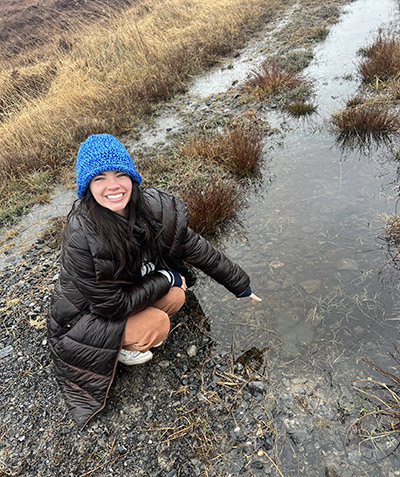
Sophomore wildlife major Arlene Polar had always wanted to visit Ireland. When a friend she met during Ag Week 2022 told her about an Ireland study abroad trip, she was intrigued. After further investigation, what she found were two options for a Spring Break trip, one oriented towards animal production and another aimed at rural development.
“I have always wanted to visit Ireland; it’s been on my list for as long as I can remember,” Polar said. “I wanted to go see cows in Ireland, but I wasn’t sure I really wanted to spend my whole week on a farm. When I read about the rural development trip, I thought, well, it checks off Ireland, it’s something different and I’ll get to work with the community. It really was just a leap of faith, to be honest.”
The choice to be part of the “Exploring Rural Development in Ireland” study abroad trip, led by Drs. Michael Wilcox and Aaron Thompson, turned out to be beyond anything Polar could have hoped.
“How our group connected, I don’t think I’ll ever experience anything like that again, because we were all from different backgrounds and doing different majors, yet we meshed up in this perfect harmony,” Polar said. “These people were strangers, yet we fit in together so well so fast. I was doubtful at first, but we worked hard and made these amazing projects come to life. It was just an amazing experience overall. I don’t have any other words to describe my time in Ireland besides that.”
The trip description states:
This study abroad program is focused on examining the factors that have and are influencing community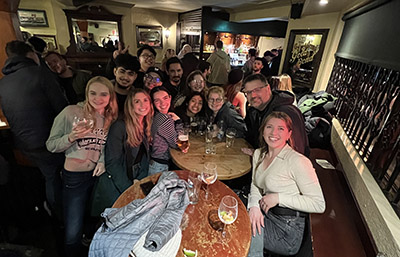 development in Ireland. Through a holistic and experiential approach, participants will be immersed in examples of rural and urban Ireland and set on a quest to understand how the interplay between social, political, cultural, financial, legal, and technological forces and the built, natural, educational, and health-related environments affect community vitality. Purdue students will collaborate with students from the National University of Ireland Galway to learn more about Irish agriculture, history, economics, community development, natural resource management, and tourism through interactive field trips and community partner visits. As an immersive experience, the schedule will be flexible enough to take advantage of unique opportunities as they present themselves and robust enough to allow students to see a side of Ireland that isn't on the typical tourist itinerary.
development in Ireland. Through a holistic and experiential approach, participants will be immersed in examples of rural and urban Ireland and set on a quest to understand how the interplay between social, political, cultural, financial, legal, and technological forces and the built, natural, educational, and health-related environments affect community vitality. Purdue students will collaborate with students from the National University of Ireland Galway to learn more about Irish agriculture, history, economics, community development, natural resource management, and tourism through interactive field trips and community partner visits. As an immersive experience, the schedule will be flexible enough to take advantage of unique opportunities as they present themselves and robust enough to allow students to see a side of Ireland that isn't on the typical tourist itinerary.
The trip was geared toward landscape architecture majors, but the 2023 student group was comprised of seven horticulture and landscape architecture (HLA) students and five from other majors.
“They wanted to have a balance,” Polar said. “They wanted to have a little bit of everything when it came to the community planning that we did on the trip, and it really worked out amazingly. We went in with fresh eyes and fresh minds and brought in all the ideas of the natural areas we had been to and tried to make it best work to fit that community. Everybody played to their strengths and the whole community was amazed with what we did.”
The group was divided into two projects: redesigning a walled garden on the property at Bellew Estate, the land the community of Mountbellew was built around, and one to enhance visitor experience and bring eco-tourism to Carrownagappul Bog, also known as Galway’s Living bog.
“This bog is very special, because it is a raised bog and they are almost extinct in Ireland,” Polar explained.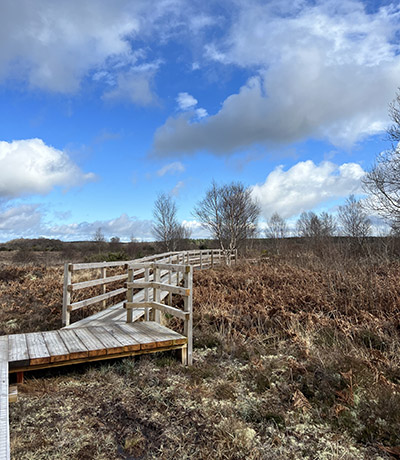 “Bogs are harvested for peat, which is used for heating in Ireland. It is part of their historic culture. If a family owns a house, most families also own the rights to a bog. You can’t sell your bog. If you sell your house, you can give your bog up to the government and it becomes a protected area. The bog we were working at is comprised of 250 bogs that have previously been owned by Irish families and it is now the biggest protected bog in all of Ireland.”
“Bogs are harvested for peat, which is used for heating in Ireland. It is part of their historic culture. If a family owns a house, most families also own the rights to a bog. You can’t sell your bog. If you sell your house, you can give your bog up to the government and it becomes a protected area. The bog we were working at is comprised of 250 bogs that have previously been owned by Irish families and it is now the biggest protected bog in all of Ireland.”
Before the group started working on their projects in Mountbellew, they spent time in Dublin and Galway City to get acclimated followed by four days glamping in an area of Galway closer to Mountbellew, a day in Athlone and one more in Dublin.
In Dublin, the group visited the Irish Immigration Museum to learn about the history of the Irish people and their accomplishments worldwide. They also explored the city, visiting cathedrals and St. Stephen’s Greens Park among others locations with a hop-on, hop-off bus pass at their disposal.
“I didn’t have any cell signal the first day, so I took that as a challenge for myself and I walked all of Dublin with a paper map and no phone,” Polar shared. “I just walked and walked without any type of destination. It was funny because I would be walking and meet people from my group, ask where they had been and we would chat on the street and just keep walking. I saw a lot of different things. I didn’t even know what I was looking at in the moment, but I was seeing everything in my mind’s eye because I didn’t have my phone and I am not mad about that. I walked all of Dublin and made it back in one piece. I’m so glad that the whole group was like, ‘let’s go walk and go adventure. Let’s go see what we find and whatever happens we will deal with it at the moment.’ We were all open to the idea of doing new things. I couldn’t have asked for a better random group of people to go to Ireland with. And Dr. Wilcox and Dr. Thompson were amazing about giving us the space to go out, have fun and be young adults within the regulations. It was an amazing way to start the trip and get to know each other, to gain confidence and be able to challenge ourselves in a safe way even though we were really far from home.”
whole group was like, ‘let’s go walk and go adventure. Let’s go see what we find and whatever happens we will deal with it at the moment.’ We were all open to the idea of doing new things. I couldn’t have asked for a better random group of people to go to Ireland with. And Dr. Wilcox and Dr. Thompson were amazing about giving us the space to go out, have fun and be young adults within the regulations. It was an amazing way to start the trip and get to know each other, to gain confidence and be able to challenge ourselves in a safe way even though we were really far from home.”
The study abroad group took similar time to explore Galway and Athlone and the sense of adventure and boldness to speak to locals was put to good use as they went out to meet community members and get feedback about their projects.
“Our professors told us we were completely on our own. They said go and do whatever you want in the community, talk to whomever you want, look around, take pictures, make annotations of what captures your attention,’” Polar recalled. “That was our first full day, and then we got to meet the people who were doing the development in the community and the community leaders. We got to learn how the government works in Ireland, where all counties have to contact Dublin because they basically don’t have their own individual governments, just a group of local leaders. I think the way the whole community functions is mesmerizing. The fact that they don’t have a government figure in the community just a community group leading, yet I saw no fights and everything was clean and the people were so nice, it was just so different and refreshing. It was a big change from what you would expect in the U.S.”
 A collage of photos of the Ireland study abroad group: the group's first night in Galway after a group dinner at Monroe's Restaurant; Dr. Thompson and Ryan Schumacher while hiking Croagh Patrick; Signs at our incredible hike at Croagh Patrick. This is known as the pilgrim hike in County Mayo, Ireland; Dr. Thompson and Ryan Schumacher standing in a garden in Dublin; first night out as a group in Dublin; Arlene's view while hiking Croagh Patrick; the group getting to know each other in Dublin
A collage of photos of the Ireland study abroad group: the group's first night in Galway after a group dinner at Monroe's Restaurant; Dr. Thompson and Ryan Schumacher while hiking Croagh Patrick; Signs at our incredible hike at Croagh Patrick. This is known as the pilgrim hike in County Mayo, Ireland; Dr. Thompson and Ryan Schumacher standing in a garden in Dublin; first night out as a group in Dublin; Arlene's view while hiking Croagh Patrick; the group getting to know each other in Dublin Polar was also impacted by the work of three local women who manage the Mountbellew Welcome Center. Half of the center building is a printing company, which is what brings in the money to keep the heating and air conditioning on and allows them to run the welcome center.
Half of the center building is a printing company, which is what brings in the money to keep the heating and air conditioning on and allows them to run the welcome center.
“There are three women working at the center: Maura Hannon, Marie Gilmore and Kiaya King. They are the center. They live and breathe that center,” Polar said. “Maura crochets hats and sells them as another way of income. Marie prepares candles and she sells them to bring in money for the center and the printing station. All three of them manage the printing station and center. When we learned that, we asked how is it that they aren’t receiving more help. Our biggest focus after that was just finding a way to get more income to them so that they can start expanding. I think it is impressive that they have done so much and have so little resources to be able to do it. I love them so much and I got to learn so much from them. They are amazing women and the fact that they are carrying the whole center on their backs was very impressive.
“It reminded me of my mom. When I was growing up my parents got divorced, so I lived with my mom my whole life. It was just her and I in the house and she would do everything. Meeting these women and seeing what they are doing was a really nice, touching way to bring in my mom. It felt like a full circle moment, because now I’m going out and learn about these different communities and I can see all of the things that my mom taught me as a little kid, and recognize the effort. I’m very excited to keep travelling and being able to see my mom in the little things that I see whenever I travel.”
One unique thing that Polar saw in Ireland was the Carrownagappul bog, a raised bog. The moss itself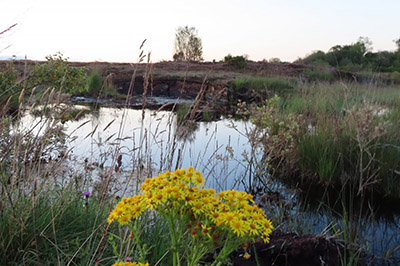 grows just one millimeter per year, but the more the moss absorbs water, the more the bog rises. The bog also provides a unique ecosystem and biodiversity.
grows just one millimeter per year, but the more the moss absorbs water, the more the bog rises. The bog also provides a unique ecosystem and biodiversity.
“Once you harvest the moss, you create a hole and the water comes out and it deflates,” Polar said. “Being able to hear the background on that natural resource and how important it has been to the history of Ireland and how all of the local families and the community connect to this one single bog, it made me think of how it is said that trees have a system of communication underground through their roots. That is all I could think of every time people talked about the bog and how all of Galway County is connected to the bogs. They’re interlaced. The people know the flowers and the plants and the animals that come by and they’re connected to the natural resources that have been surrounding them since birth and it gets passed through generations. You can’t take the bog out of Ireland or Ireland out of the people. There is a saying that Ireland never leaves you. The way everything just comes into this perfect harmony – the history, the people, the bog, the protection of it, and what we were doing there – was very impactful.”
Bogs like Carrownagappul once occupied nearly a million acres of land, but according to The Living Bog, less than one percent of that remains as active, living bogs that can support life today. Peat moss has been harvested for generations for heat and is very much engrained in the lives of locals, although the culture is slowly changing.
“Something that really impacted me was when we went out and talked to the community members, I talked to somebody who was 40 years old who went out and cultivated the bog and harvested peat as a child,” Polar recalled. “This bartender in a really small pub told me it has been a drastic change for them generationally, because harvesting peat was their whole life. They would go to the bog all summer to harvest peat and that was how they survived. Whatever they harvest lasted them all winter. It has been hard for the older generations to assimilate that that isn’t the lifestyle anymore. It is a dying part of their history and it is celebrated very much, but they are starting to learn that they are hurting their own resources. They are losing the biodiversity that Ireland has because bogs are a very specific landscape. The soils are very acidic and whatever grows and lives there can only do it there. The biodiversity in bogs is so specialized that once you lose the bog, you lose all of the biodiversity.”
Despite the increased awareness, Polar noted that the bartender she spoke with was still burning peat for the fire to keep the bar warm.
“My professor asked how I felt about the peat being burned right in front of me,” Polar said. “I couldn’t be mad at it because they have this huge bog they are trying to protect. It is a give and take. Humans live off nature, that is a reality, but I believe humans can find a balance of giving back to nature, while they take. That is one of the most important things that we as a community, not only in the USA or Ireland, need to learn in order to be able to survive. Mother Earth is here to take care of us and we live on it because we can, but we need to learn a better way of managing our resources.”
At the end of the trip, the students gathered at a local pub to present their projects to the whole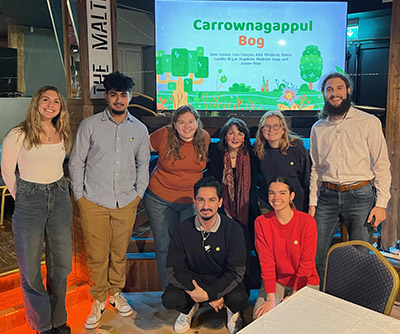 Mountbellew community, including community leaders, investors, the caretakers of the center, and those from the town invested in its history and the arts scene. Students presented a 10-year plan and divided it into things that could be done in two years, in five years and beyond.
Mountbellew community, including community leaders, investors, the caretakers of the center, and those from the town invested in its history and the arts scene. Students presented a 10-year plan and divided it into things that could be done in two years, in five years and beyond.
At first, Polar was concerned about why the Mountbellew residents would care about what a bunch of American students thought they should do with their land and the bog.
“At the beginning I was very nervous if a rural community in Ireland was really going to accept us. I was really curious why we were coming in and telling them to fix this or fix that,” Polar said. “But Dr. Thompson said something that was very important. He told us that we were not telling them what to do; they asked us to come here. That is why it was so important for us to practice how we are going to verbalize our findings and our project, because we want to help the development of the community. I have never been a part of a project that felt so humanitarian. They welcomed us with open arms and were so grateful that we took the time to sit down, hear them out, learn about their culture and then incorporate it into our projects.
“They told us we did an amazing job making their culture shine through the project, while putting an American twist on it. The thing I remember the most that they told us was ‘You came in and you highlighted our problems. And they are problems that can be fixed and you gave us solutions that we can do.’ They said it was easy to understand the image that we had for their community and how it could benefit them.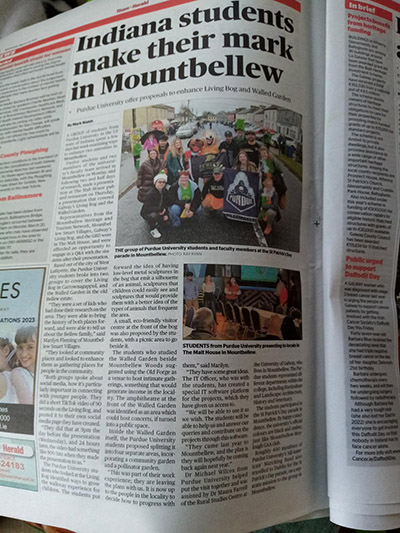 They put us in their newspaper and the article gave me a lot of emotions seeing how happy they were that we were there. We also got invited to come back as a group or as individuals.”
They put us in their newspaper and the article gave me a lot of emotions seeing how happy they were that we were there. We also got invited to come back as a group or as individuals.”
The walled garden project likely will be implemented as there is private funding for the renovation project on the private estate. The future of the bog project is up in the air.
“I don’t know what is going to happen with the bog mostly because of how the funds work for them and how natural resources are managed in Ireland,” Polar explained. “It is a very nitpicky process working with the government on natural resources in Ireland.”
One aspect of the bog plan that Polar is determined to carry on even after leaving Ireland behind is helping the bog become more well-known to open up ecotourism.
“We really wanted to focus on getting the bog more well known through social media, to get the education out there and see how we can help them in that way,” Polar said. “I want academia to recognize what they are doing because that is what they need. They don’t want to focus on bringing in tourists that are going to damage the natural area, they want to bring in people like academics or people in FNR or conservation, things like that, who will appreciate what they are doing with the bog.”
Those interested in learning more about the Welcome Center and the bog can follow @galwayslivingbog on Instagram or visit the bog’s website.
Polar’s work on the bog brought her education abroad full circle, surprisingly tying into the identification and classification of moss she had learned while taking a Tropical Biology for Undergraduates course through the Organization for Tropical Studies (OTS) during the summer of 2022.
“One of the professors from the University of Galway said that I connected with the people in a way that she had never seen students connect with them before, and I think it was because in Costa Rica my individual research project was the classification of moss and bryophtyes and the bog is comprised of moss,” Polar explained. “When I got there, I got excited. I asked who did the classification of the moss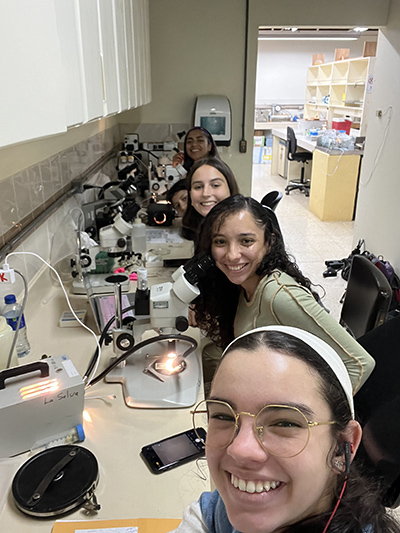 species because they said they only have 24 species of moss. That seemed curious for such a big place. They asked if I knew how to do it and I said I only knew how to do it by morphology, but it is something that I have done. We started talking about Costa Rica and she said if I want to come and do my master’s there and work in the bog, I would be more than welcome to.”
species because they said they only have 24 species of moss. That seemed curious for such a big place. They asked if I knew how to do it and I said I only knew how to do it by morphology, but it is something that I have done. We started talking about Costa Rica and she said if I want to come and do my master’s there and work in the bog, I would be more than welcome to.”
Although the two experiences were linked by moss, Polar is quick to point out that they exercised very different sides of her brain and personality.
“Ireland was definitely more freeing and I learned more from myself in a social aspect and challenged myself and my cultural knowledge, what I’ve learned of networking with people and my observations around culture,” Polar said. “I am a wildlife major and environmental sciences minor, so that is where the drift came in. Costa Rica was very much an educational challenge, dedicated to the wildlife aspect of my brain, while Ireland was for the liberal arts part of my brain. In Costa Rica, we were going to learn the scientific method, we were going to go to the lab and learn how to count pollen or learn new species, etc. I was in a very different mental headspace in Ireland, which was very refreshing. I don’t know which side I enjoyed more at this point, the scientific aspect or the social aspect of how to deal with natural resources.”
Although the work and networking were impactful, it wasn’t all work and no play for Polar and her classmates. The group participated in the Mountbellew St. Patrick’s Day Parade. They also socialized with locals, tourists and other students throughout the trip.
“We got to walk in the parade and hand out candy,” Polar shared. “The ‘mayor of the town,’ if that is how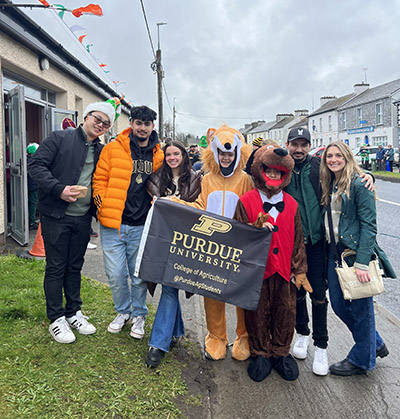 you want to put it, gave us a little introduction and talked about why we were there and how we were going to help the community. People were just smiling at us and saying hi. And then, we got to dance in the parade as well. It was like a flash mob. We just walked in and learned the dance while they were doing it. That was really fun. We also got to go out to the pubs in Galway and met other students who were on study abroad and people that were there with their families. I took the time to talk to everybody that I could. I think that was my favorite part, getting to talk to the people and getting to know the people that live in Ireland. We met people from Texas to Ireland to Canada and created so many memories. It was so cool; I didn’t want to come back.”
you want to put it, gave us a little introduction and talked about why we were there and how we were going to help the community. People were just smiling at us and saying hi. And then, we got to dance in the parade as well. It was like a flash mob. We just walked in and learned the dance while they were doing it. That was really fun. We also got to go out to the pubs in Galway and met other students who were on study abroad and people that were there with their families. I took the time to talk to everybody that I could. I think that was my favorite part, getting to talk to the people and getting to know the people that live in Ireland. We met people from Texas to Ireland to Canada and created so many memories. It was so cool; I didn’t want to come back.”
Polar will expand her horizons again in July as she travels to Sweden and Norway with Drs. Barny Dunning, Tomas Hook and Doug Jacobs for an International Natural Resources study abroad trip. The four-week course will examine natural resources broadly defined, including forestry, fisheries, wildlife, agriculture, mining, outdoor recreation, and urban sustainability. Students will define, discover, and document examples where sustainability of resource use matters. The course explores the effect of terrain, climate, vegetation, faunal assemblages, social structures and technologies on natural resource use.
“I’m so excited,” Polar said. “My mom says every time I go to a new place, my energy tops what I had before. I just feel it makes a more well-rounded person and I wouldn’t change it for anything. I’m very grateful for study abroad experiences. They just help you open up your mind in every way possible.”
 A collage of photos from the study abroad trip to Ireland: Part of the tour at the Bellew Estate, given by Jimmy Noone, resident of Mountbellew. Shown here is the furnace used for blacksmithing.; Arlene found frog eggs at the Carrownaggapul Bog; Part of the group walking through Dublin. Behind them is the Temple Bar, one of the most famous pubs in Dublin; group dinner while staying at Galway Glamping, where they stayed while working with the community at Mountbellew; Sean’s Bar, Ireland’s Oldest Pub 900 AD; The Walled Garden Group before presenting final project. From left to right: Dr. Michael Wilcox, Lauren Drabenstott, Alejandra Hughes, Ryan Schumacher, Madelyn Minns and Andrew Waskin; The group at the Carrownagapul bog; Part of the group at the Mountbellew St. Patrick’s Day parade; the bog group after presentation. From left to right, Emma Luedke, Luis Campos, Alex Weidman, Marie Gilmore (nature guide), Madelyn Lopp, Bryan Stapleton, Juan Lozano and Arlene Polar; View from the boardwalk at the Carrownaggapul Bog; Part of the group at the Bellew Estate. From left to right: Luis Campos- Landscape Architecture (LA), Alejandra Hughes-LA, Juan Lozano- LA, Alex Weidmen- NRES, Arlene Polar- Wildlife, Madelyn Lopp- NRES, Emma Luedke- LA
A collage of photos from the study abroad trip to Ireland: Part of the tour at the Bellew Estate, given by Jimmy Noone, resident of Mountbellew. Shown here is the furnace used for blacksmithing.; Arlene found frog eggs at the Carrownaggapul Bog; Part of the group walking through Dublin. Behind them is the Temple Bar, one of the most famous pubs in Dublin; group dinner while staying at Galway Glamping, where they stayed while working with the community at Mountbellew; Sean’s Bar, Ireland’s Oldest Pub 900 AD; The Walled Garden Group before presenting final project. From left to right: Dr. Michael Wilcox, Lauren Drabenstott, Alejandra Hughes, Ryan Schumacher, Madelyn Minns and Andrew Waskin; The group at the Carrownagapul bog; Part of the group at the Mountbellew St. Patrick’s Day parade; the bog group after presentation. From left to right, Emma Luedke, Luis Campos, Alex Weidman, Marie Gilmore (nature guide), Madelyn Lopp, Bryan Stapleton, Juan Lozano and Arlene Polar; View from the boardwalk at the Carrownaggapul Bog; Part of the group at the Bellew Estate. From left to right: Luis Campos- Landscape Architecture (LA), Alejandra Hughes-LA, Juan Lozano- LA, Alex Weidmen- NRES, Arlene Polar- Wildlife, Madelyn Lopp- NRES, Emma Luedke- LA 





